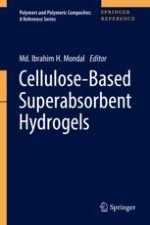Abstract
Among all biomass, cellulose is the most abundant renewable polysaccharide in nature, accounting for approximately 40% of the lignocellulosic biomass. The ability of cellulose to absorb enormous amounts of water has prompted the large use of cellulose in preparation of various hydrogels. Cellulose-based hydrogels are generally synthesized by two steps, (i) solubilization of cellulose fibers or powder and (ii) physical and/or chemical cross-linking, in order to obtain a three-dimensional network of hydrophilic polymer chains. The physical synthesizing method includes ionic interaction, hydrophobic interaction, and hydrogen bond formation, whereas the chemically cross-linked hydrogel preparation involves different polymerization techniques such as chain-growth polymerization, irradiation polymerization, and step-growth polymerization. Further, another technique such as bulk polymerization is also used to form gels mainly using lactic acid as monomer. Indeed, the high density of free hydroxyl groups present in the cellulose structure permits them to undergo functionalization/chemical modification, which allows producing cellulose derivatives. The properties of cellulosic hydrogels change based on the different environmental stimuli. The external stimulus includes pH, temperature, light, electric or magnetic field, mechanical stress, etc. The responses of the hydrogel based on the exposure to different stimuli are discussed in this chapter. However, the cellulose hydrogels basically have good biocompatibility and non-toxicity combined with relevant mechanical properties. They showed highest absorption capacity, the swelling/deswelling behavior, and its rate depends on various factors such as particle size, porosity, solvent concentration, cross-linking density, etc. The swell behavior is addressed using various kinetic models such as Fickian, non-Fickian, and Flory. Further, biodegradation, mechanical, and rheological properties variation with respect to cross-linking density and other parameters (shape, pore size, reinforcement, etc.) and stimuli are considered and discussed.
